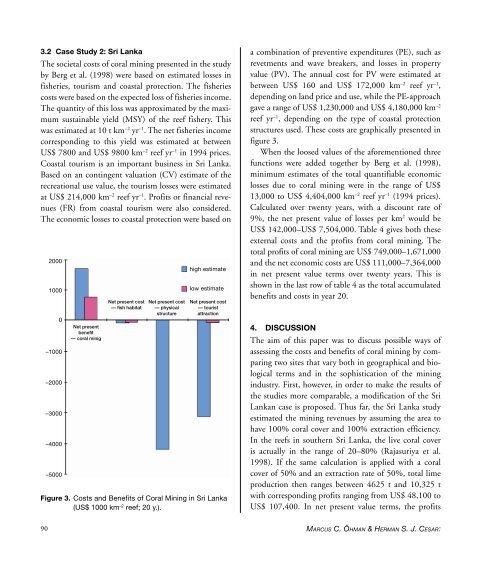Create successful ePaper yourself
Turn your PDF publications into a flip-book with our unique Google optimized e-Paper software.
3.2 Case Study 2: Sri Lanka<br />
The societal costs <strong>of</strong> coral mining presented in the study<br />
by Berg et al. (1998) were based on estimated losses in<br />
fisheries, tourism and coastal protection. The fisheries<br />
costs were based on the expected loss <strong>of</strong> fisheries income.<br />
The quantity <strong>of</strong> this loss was approximated by the maximum<br />
sustainable yield (MSY) <strong>of</strong> the reef fishery. This<br />
was estimated at 10 t km –2 yr –1 . The net fisheries income<br />
corresponding to this yield was estimated at between<br />
US$ 7800 and US$ 9800 km –2 reef yr –1 in 1994 prices.<br />
Coastal tourism is an important business in Sri Lanka.<br />
Based on an contingent valuation (CV) estimate <strong>of</strong> the<br />
recreational use value, the tourism losses were estimated<br />
at US$ 214,000 km –2 reef yr –1 . Pr<strong>of</strong>its or financial revenues<br />
(FR) from coastal tourism were also considered.<br />
The economic losses to coastal protection were based on<br />
2000<br />
1000<br />
0<br />
–1000<br />
–2000<br />
–3000<br />
–4000<br />
–5000<br />
Net present<br />
benefit<br />
— coral minig<br />
Net present cost<br />
— fish habitat<br />
Net present cost<br />
— physical<br />
structure<br />
high estimate<br />
low estimate<br />
Net present cost<br />
— tourist<br />
attraction<br />
Figure 3. Costs and Benefits <strong>of</strong> <strong>Coral</strong> Mining in Sri Lanka<br />
(US$ 1000 km –2 reef; 20 y.).<br />
a combination <strong>of</strong> preventive expenditures (PE), such as<br />
revetments and wave breakers, and losses in property<br />
value (PV). The annual cost for PV were estimated at<br />
between US$ 160 and US$ 172,000 km –2 reef yr –1 ,<br />
depending on land price and use, while the PE-approach<br />
gave a range <strong>of</strong> US$ 1,230,000 and US$ 4,180,000 km –2<br />
reef yr –1 , depending on the type <strong>of</strong> coastal protection<br />
structures used. These costs are graphically presented in<br />
figure 3.<br />
When the loosed values <strong>of</strong> the aforementioned three<br />
functions were added together by Berg et al. (1998),<br />
minimum estimates <strong>of</strong> the total quantifiable economic<br />
losses due to coral mining were in the range <strong>of</strong> US$<br />
13,000 to US$ 4,404,000 km –2 reef yr –1 (1994 prices).<br />
Calculated over twenty years, with a discount rate <strong>of</strong><br />
9%, the net present value <strong>of</strong> losses per km 2 would be<br />
US$ 142,000–US$ 7,504,000. Table 4 gives both these<br />
external costs and the pr<strong>of</strong>its from coral mining. The<br />
total pr<strong>of</strong>its <strong>of</strong> coral mining are US$ 749,000–1,671,000<br />
and the net economic costs are US$ 111,000–7,364,000<br />
in net present value terms over twenty years. This is<br />
shown in the last row <strong>of</strong> table 4 as the total accumulated<br />
benefits and costs in year 20.<br />
4. DISCUSSION<br />
The aim <strong>of</strong> this paper was to discuss possible ways <strong>of</strong><br />
assessing the costs and benefits <strong>of</strong> coral mining by comparing<br />
two sites that vary both in geographical and biological<br />
terms and in the sophistication <strong>of</strong> the mining<br />
industry. First, however, in order to make the results <strong>of</strong><br />
the studies more comparable, a modification <strong>of</strong> the Sri<br />
Lankan case is proposed. Thus far, the Sri Lanka study<br />
estimated the mining revenues by assuming the area to<br />
have 100% coral cover and 100% extraction efficiency.<br />
In the reefs in southern Sri Lanka, the live coral cover<br />
is actually in the range <strong>of</strong> 20–80% (Rajasuriya et al.<br />
1998). If the same calculation is applied with a coral<br />
cover <strong>of</strong> 50% and an extraction rate <strong>of</strong> 50%, total lime<br />
production then ranges between 4625 t and 10,325 t<br />
with corresponding pr<strong>of</strong>its ranging from US$ 48,100 to<br />
US$ 107,400. In net present value terms, the pr<strong>of</strong>its<br />
90<br />
MARCUS C. ÖHMAN & HERMAN S. J. CESAR:


















